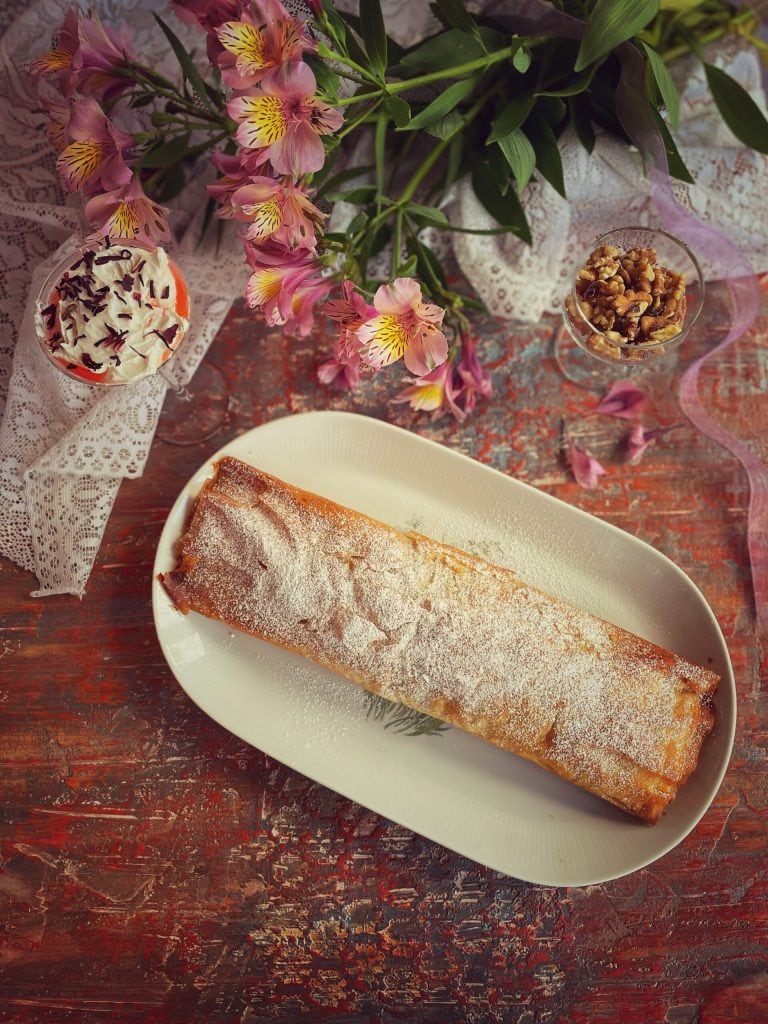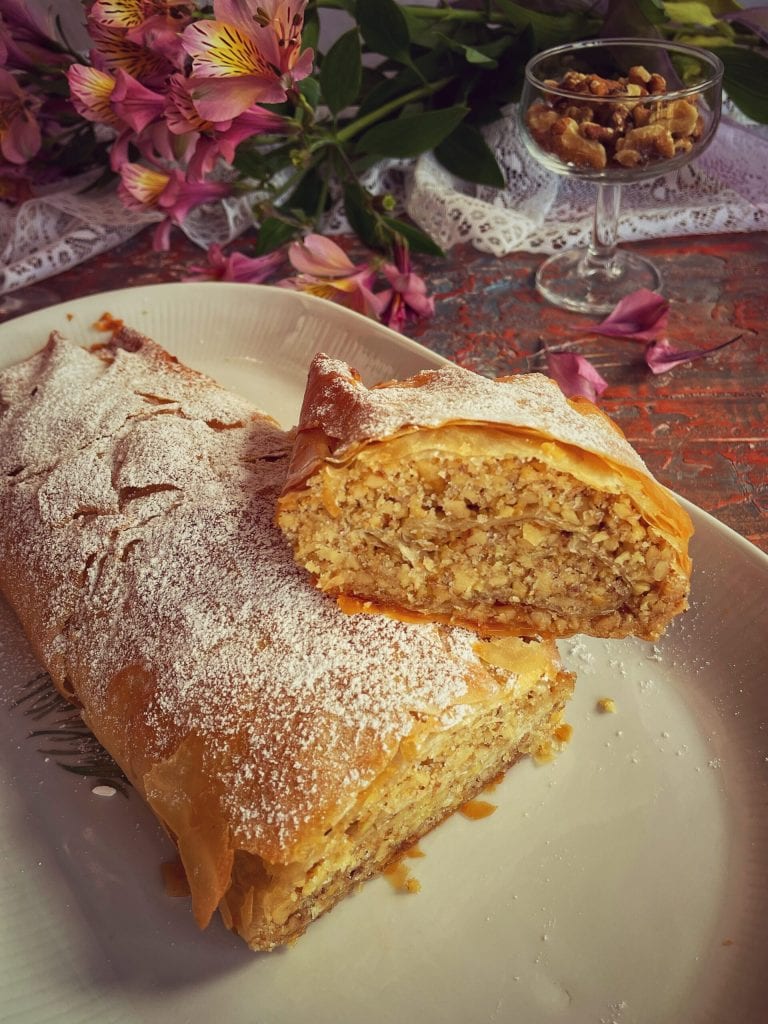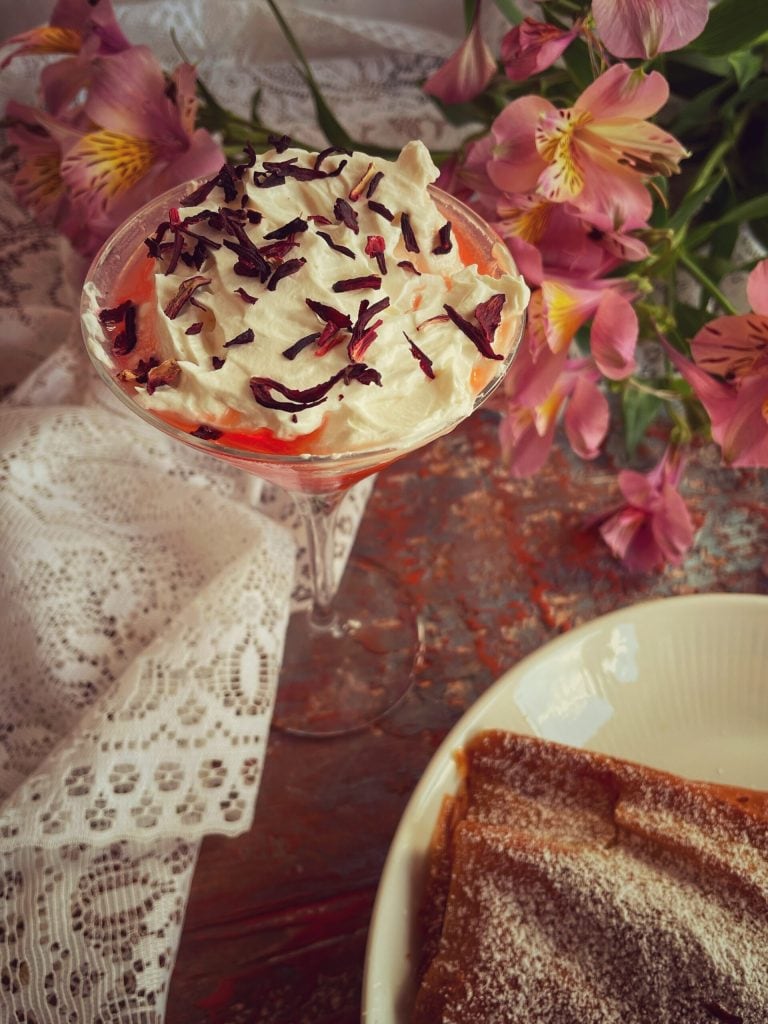The Diós Rétes is the famous Hungarian walnut strudel.
The strudel, although known by its German name in most linguistic areas, was once called by its Hungarian name: rétes.
The menu of the Ritz Hotel in Paris at the beginning of the 19th century, for example, included “Rétes Hongrois”, for which strudel flour was ordered from Hungary and pastry chefs were sent to Pest to learn.
In Hungary, the most common fillings for rétes include: ricotta with raisins (túrós rétes), sour cherries (meggyes rétes), apples (almás rétes), poppy seeds (mákos rétes), walnuts (diós rétes), and once even sour cream and tejberizs (sweet rice porridge) were common.
In Hungary, it is consumed during Farsang or New Year because it is believed to bring good fortune and long life.
The traditional dough for Hungarian Diós Rétes is not the classic French puff pastry, but rather a hand-stretched dough, very thin, almost transparent, known in Hungarian as rétestészta.
It can be substituted with ready-made filo pastry (4 sheets).

- Difficulty: Medium
- Cost: Economical
- Rest time: 1 Hour
- Preparation time: 20 Minutes
- Portions: 6 People
- Cooking methods: Oven, Electric Oven
- Cuisine: Hungarian
- Seasonality: All seasons
Ingredients
- 4 1/4 cups flour
- 1 egg
- 1 tablespoon white vinegar
- 1 teaspoon salt
- 2 tablespoons vegetable oil (or lard + for brushing)
- 1 cup warm water
- 12 oz walnuts (finely chopped)
- 1 1/2 cups sugar
- 1 packet vanillin
- 1 lemon (zest)
- as needed vegetable oil
- as needed powdered sugar
Steps
Sift the flour into a large bowl.
Add salt, egg, vinegar, and oil.
Gradually mix in the warm water until a smooth and elastic dough is obtained.
Knead vigorously for at least 10 minutes.
Shape the dough into a ball and lightly grease it with oil.
Cover with plastic wrap and let it rest at room temperature for at least 30 minutes, preferably 1 hour.
Cover a table with a clean, floured cloth.You can substitute with filo pastry by layering 4 sheets brushed with melted butter.

In a bowl, mix the chopped walnuts with sugar, vanillin, and grated lemon zest.
On a floured cloth, roll out the dough as thinly as possible, until it becomes almost transparent.Roll out the dough with a rolling pin.
Then, using the back of your hands, gently stretch the sheet from the center outwards until it is almost transparent.
Cut off any thicker edges if necessary.
Brush the surface with oil.Evenly distribute the filling over the rolled-out dough, leaving a free edge of about 3/4 inch.
Roll the dough gently with the help of the cloth, forming a roll.
Seal the ends and transfer the roll to a baking sheet lined with parchment paper.
Preheat the oven to 350°F.
Brush the surface of the rétes with oil.
Bake for about 30-35 minutes, or until the surface is golden and crispy.
Allow to cool slightly, then sprinkle with powdered sugar.
Slice and serve warm or at room temperature.
The Strudel in Jewish Culture:
The strudel (in Yiddish: שטרודל, pron. shtrudl) is generally also associated with Ashkenazi Jewish cuisine, particularly of German, Swiss, and Austrian Ashkenazi Jews.
Cabbage strudel (káposztás rétes in Hungarian) is particularly associated with the cuisine of Hungarian Jews.
Observant Hungarian Jews prepared the dough with oil and served the strudel for Simchat Torah and Purim, to pair it with the customary drink consumed during these celebrations.
In colloquial Hebrew, the @ symbol in email addresses is called “shtrudel” שטרודל, a German loanword for the pastry.
In colloquial Hebrew, the @ symbol in email addresses is called “shtrudel” שטרודל, a German loanword for the pastry.
I accompanied the dessert with a Thyme, Hibiscus, and Basil Sherbet from a recipe in the book “Aromatic Drinks” by Ottavia Castellaro with a topping of whipped cream.
“Sherbet” refers to a drink of Arab (sharab) or Middle Eastern origin (sharbat) that is made with fruit, flowers, or other ingredients, to which sugar and acid (like citrus juices) are added to create a fresh and refreshing flavor.

FAQ (Questions and Answers)
What are the differences between French puff pastry and rétestészta?
Main differences:
Classic puff pastry (French): made with butter and repeated folds (long and layered process).
Rétestészta (rétes dough): simple dough with flour, water, vinegar, a little oil or lard, without butter or layering.
It is very elastic and is hand-stretched on a cloth until it becomes very thin (like gauze).

